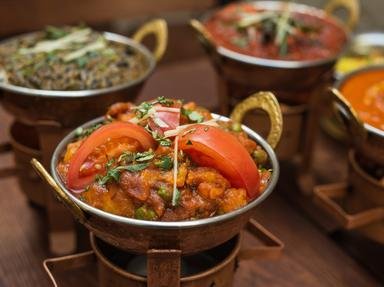Quiz Answer Key and Fun Facts
1. Welcome, honoured guest to our daylong feast. In this heat it is always best to eat fish early in the day whilst it remains fresh, so our first dish will be an Anglo adaptation of the traditional Indian dish of khichri, or khichdi; a combination of rice, spice and lentils. Our British recipe has taken away the lentils and added boiled eggs and haddock. What is this concoction that we are serving?
2. For those not too keen on fish at this time in the morning, we have a selection of alternative dishes for you all. There's rumble-tumble, craggy toast and ox eyes. The key ingredient to all these dishes has been produced here from animals brought over from England. What is that ingredient?
3. After such a hearty breakfast, I suggest everyone retires to the veranda for a while to rest. I will call everyone back when its time to serve Tiffin. In the time of the British Raj, what was Tiffin?
4. The dish we are serving for our midday meal is a chicken curry dish that has reached out beyond the British Raj to achieve popularity in the Southern US. The chicken is cooked with onions, ginger, garlic and turmeric although not the raisins that are usually added to the American version of the dish. Do you know what we are serving?
5. After a leisurely game of croquet on the lawn and as the sun begins its descent towards the horizon, we shall be serving aperitifs. Sherry is available for the ladies but for the gentlemen, we have one of British India's most famous concoctions; three parts gin to one part lime juice with a dash of soda water. Do you know what this cocktail is called?
6. If you've all finished your drinks and are steady enough, then please make your way to the dining room. You will soon be served your starter; a soup that was created by the British adding meat and stock to the local "pepper water" soups. The soup's name comes from two words meaning "pepper" and "water". What is our starter?
7. The centrepiece of the day's offerings is a fine bird that you wouldn't find on the menu back in Old Blighty. However, out here in the time of the Raj, in the absence of turkey this would often be the main meat in the Christmas meal. Which glamorous bird, the national bird of India, is it?
8. As well as adapting Indian styles of cooking into their own diets, the British introduced new vegetables to the Indian diet. One such vegetable was the cauliflower. Our vegetable accompaniment to the main course is a dish containing cauliflower. Which dish is this?
9. In the centre of the table you will find some condiments that you should recognise from your larder at home in Britain. It may surprise you to learn that one of them comes from a recipe that was devised in India. Do you know which one?
10. After such a large dinner, it is probably best that we end on something light, a simple dessert of a fruit with condensed milk. This fruit, native to India, was a revelation to the British when they arrived here but now is ubiquitous in Indian restaurants and supermarkets across the UK, in its chutney form. Which juicy orange-fleshed fruit is it?
Source: Author
Snowman
This quiz was reviewed by FunTrivia editor
Bruyere before going online.
Any errors found in FunTrivia content are routinely corrected through our feedback system.


